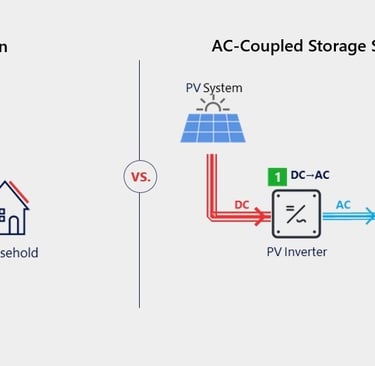Big savings, less hassles. Check out our newly launched DIY solar kits! 🌞⚡
AC vs. DC Coupling: A Simple Explanation
Demystify the confusing jargon: AC vs DC
10/27/20232 min read


There are three Popular Ways to Connect Solar Batteries:
AC Coupling:
Think of it as a two-step dance. First, the sun's energy is changed into a type we use in our homes. Then, any extra energy is stored in the battery.DC Coupling:
This is more like a direct path. The sun's energy goes straight into the battery without any major changes.Hybrid System:
It's like having the best of both worlds. This system uses features from both AC and DC coupling.
Each method has its own strengths and weaknesses, and the best one for you depends on your specific needs. Let's break it down in simple terms to understand them better. Imagine your solar panels as a water tap, and the energy they produce as water. Now, you want to store this water in a tank (the battery) for later use.
DC Coupling (Direct Connection):
In a DC-coupled system, the water (energy) from the tap (solar panels) goes directly into the tank (battery). It's a straightforward process with 1 step conversion, less energy loss.
Advantages: It's more affordable since the tap and tank share the same connection. It's also efficient, as the water flows directly without any detours. Plus, you can add more taps to get more water using the same connection.
AC Coupling (Extra Steps):
In an AC-coupled system, the water first goes through a filter (inverter) to clean it, then into the tank. If the tank gets full and you still have extra water, it goes through another filter to be stored elsewhere, like the grid.
Advantages: It's flexible. If you already have a tap and later decide to get a tank, you can easily add it. It's also reliable; if there's an issue with the tank, your tap still works fine. And, you can store water from both the tap and an external source (like the grid).
Hybrid system (best of both worlds):
A hybrid system is designed from the start to work both with the tap (solar panels) and an external source (the grid). It has a special inverter that can filter water from all sources: the tap (solar panels), the tank (battery) and external source (the grid) all at once.
Flexibility: It can decide where to get water from: the tap (solar panels), the tank (battery) or external source (the grid) based on what's most efficient at the time. For instance, during a power outage, a hybrid system can still provide power from the solar panels or battery.
Energy Management: Hybrid systems often come with advanced features for energy management, allowing you to choose when to use or store solar energy or when to use grid power.
In Summary: DC coupling is a direct and efficient way to store energy, but often it does required both solar PV system and battery storage system are installed at the same time. While AC coupling offers more flexibility, especially when retrofitting battery storage system with an existing PV system or if you decide to add more batteries later on. For example, Tesla Powerwall 2 is a AC coupled system.
Contacts
Tel: 02922 642462
Email: info@sunvault.co.uk
Socials
Subscribe to our newsletter
Legal policies
Verity Vox Ltd
Company number: 15793956
VAT No.: 470 0370 25
